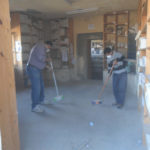As it has been quite some time since our last study season, we have been fortunate to collect an ample amount of data and material for analysis. Some of our more notable discoveries since 2003 include:
* The Western Town (2004)
* The valley complex of Queen Khentkawes (2007)
* The harbor basin of Queen Khentkawes (2009)
* The Silo Building Complex (2011)
This season gives us a much needed opportunity to further analyze the material culture within these areas and others, while considering evidence previously presented by AERA team members in order to assess the meaning of all we have found.
Taking a break from lab work, Richard visited the Giza Taftish during the first week of the study season. On January 23rd, he spoke to about 40 inspectors from the Ministry of State for Antiquities (MSA) Giza Inspectorate. Richard delivered a lecture entitled, “A Tale of Two Sites: Old Kingdom Animal Economy”.
In the coming weeks, AERA Co-Field Directors Mohsen Kamel and Ana Tavares will be working with members of the ARCE/AERA 2010 Salvage Archaeological Field School (SAFS 2010) on the publication of material culture from the Luxor Town Mound (LTM). AERA Associate Director John Nolan and Publications Manager Ali Witsel will join the lab team in March to study the new cache of clay sealings from the Silo Building Complex, which we excavated for the first time last season. We look forward to sharing these analyses and results in future AERAGRAM newsletters and publications.


